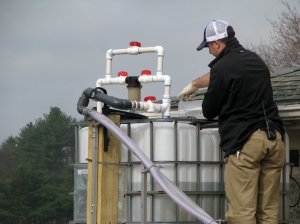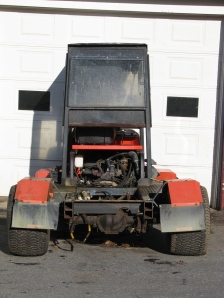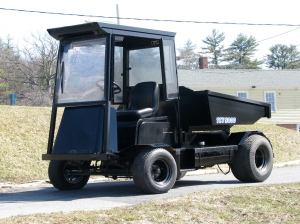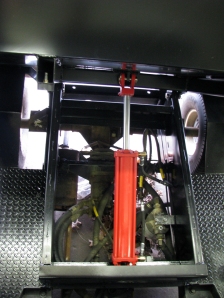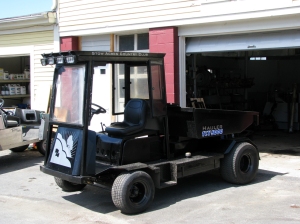This blog post was published earlier here but has a few updates.
Lately there has been a lot of talk about sustainability in golf and reducing our reliance on chemicals. For the most part if we can reduce or manage the stresses that are affecting our turf we can manage the turf pests that have the potential to kill the turf.
 |
| How often do we need to cut our greens in the winter? |
One of the most common stresses that we as turf managers force upon our putting greens is intensive mowing. Many superintendents mow their greens once or twice a day in the summertime to keep the putting greens consistent and smooth. In the summer this is often sustainable as the turf is growing and usually quite healthy. In the shoulder seasons as well as winter we often have to reduce our mowing frequency to match the changing growth rates of the turf. We have to take special care not to cut the turf too often or not enough. Cutting too much causes extra stress and cutting not enough will increase the chance of scalping unless the heights of cut are raised.
Most turf managers judge how often they cut in this uncertain growth period simply by looking at the turf. This is a great way of judging if the turf need to be cut and has been the principle method of mowing since the mower was invented.
On higher cut turf such as our tees, fairways, and rough it is quite obvious when the turf needs to be cut but on our closely cut putting greens the need for cutting isn't always as clear. Most superintendents manage their putting greens much more intensely than the other areas of the golf course as they are often the selling feature of the golf course. The putting greens are usually also the most susceptible to turf disease and pests as they are put in an almost constant state of stress.
 |
Newly planted Poa annua (foreground) had no seed head
due to not being mowed in months. |
This all became very clear to me this past summer when I made the observation that the turf on our nursery that was transplanted from cores from our
Poa annua putting green aeration did not go to seed. More about this can be read
here. After consulting with a number of my peers in the turf industry we determined that the turf didn't go to seed was because it was allowed to grow without the stress of mowing. Other
studies out there have also shown that with less frequent mowing there is a significant increase in turf quality as well as a reduction in turf disease.
This got me thinking how I could minimize my mowing frequency especially during the shoulder season and winter when I have little control over the environmental conditions stressing the turf while maintaining a consistent height of cut. I came up with a rather crude method of measuring the rate at which the turf was growing which would in turn allow me to predict when the next mowing was needed.
 |
| Equipment Use form |
Every time a piece of machinery is used on the golf course I have the operator fill out a Google form on my maintenance website with information about what was done and the machine hours. This is fed into a spreadsheet and is sorted to make sense. You can read more about this
here. I added a entry to the form asking them how many times they filled the baskets on the mower. With this information along with how long it has been since the last cut I was able to come up with a constant figure (basket fills/day). This number will allow me to judge when the turf needs to be cut next. I also have a target value of at least one basket fill per cut. I don't want to send the mower out if I will get less than one basket of grass as in my experience at Pender Harbour this causes needless stress and will not significantly improve the playing conditions on the greens. If I collect more than 1 basket I am potentially removing more than 1/3 of the leaf blade which is typically not recommended. This figure will be different for every height of cut and mower setup.
This might seem like a lot of work but it is a simple as inputting one extra piece of information each day. The spreadsheet does the rest.
In the summer time I cut as often as I can to maintain the desired conditions on the putting greens. At the Pender Harbour Golf Club we only need to cut every second day and roll daily to achieve consistent fast-rolling greens. For this club this is the most economical means of achieving these conditions.
In the winter when the turf is growing much slower I can use the growth data that I have collected to predict when the turf next needs mowing. Not only does this allow me to reduce the stress of mowing on the greens but it also allows me to maximize my labour and mower efficiencies. I know that I am only cutting when absolutely necessary.
Now you're probably thinking that this in crazy and totally leaves out the "art" in greenkeeping and you are totally right. This not an absolute tool for me but more of a guide. I allows me to better judge when my putting greens need cutting. The last thing I want is to send the mower out on the course only to find out after that almost no grass was cut or that the greens were so long that they were scalped. Either of these previous scenarios causes me concern as I just caused my putting greens stress that wasn't needed or justified. This in turn potentially will increase my chemical use which isn't ideal.
I have received a few comments about using the greens mowers to remove leaf litter and debris from the putting greens to smooth them out. This is a good way of removing the debris but I prefer to use a blower as it causes absolutely no stress to the turf.
This tool also allows me to keep my cutting heights low and consistent year-round without the worry of causing my turf excess stress. There is debate in the industry that the height of cut has less to do with turf stress than frequency of cut and I totally agree. If you can maintain your turf in a consistent manner you can maintain good healthy sustainable turf no matter the height of cut. This tool helps me do that.
In a time when efficiency and sustainability are paramount it is imperative that we as turf managers do whatever we can to reduce waste and more closely manage the stresses that we subject to our turf. We can no longer base our decisions on a hunch or guess. We need to make informed educated decisions based on the facts.
For most people this is all you will want to read. The following is for the nerdiest of the turf nerds. Directions to use this spreadsheet as well as a link to the google docs template can be found here.
My spreadsheet for this growth data is complex and is tied into my entire operations so it isn't realistic to tell you how I did this but here is a look at my growth sheet that I use to see my growth rates.
This data if filtered out of my equipment use database to show only the data inputs that show clipping collection on my putting greens with my greens mower. The spreadsheet then calculates how long it has been since the last cutting in days and then computes the growth rate in empties/day or fills/day (they are the same). Then by using my optimum empties (or fills) per cut I can calculate the recommended cutting frequency in days. This then spits out the next recommended day that I should cut on. The recommended cutting frequency is made from the average growth rate of the past three cuttings to smooth out the prediction. This makes it easier to adjust to fluctuation in the growth rate. It is basically just the growth rate divided by the optimum empties per cut figure.

The above picture shows the most recent data that I have collected. I was measuring the clipping yields long before I made this spreadsheet so you can clearly see that I have been cutting my greens more often than I needed to. If I would have had this spreadsheet up and running earlier I could have eliminated at least 2 cuttings on my putting greens or about 30% of my total times cut since I began recording the data. Over time this will mean significant savings in labour as well as a reduction in the stress on the turf.
I also have the spreadsheet to generate a nifty chart that graphs the growth rate versus time. This will really be useful in the long run for almost everything we do on the course. This graph will illustrate growth trends we are seeing and be another tool that I can use to better manage my mowing, fertility, and other cultural practices to maximize efficiency and reduce stress on the turf.
.
